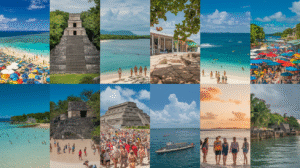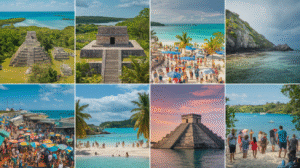Creating an unforgettable travel experience in Belize encompasses much more than merely choosing your accommodations or planning your activities—it’s essential to identify the most advantageous time for your visit. This comprehensive guide offers you invaluable insights from locals, specifically tailored to meet the real desires of travelers. By the time you finish this guide, you’ll have practical answers to the most commonly searched questions: exploring aspects such as climate, costs, wildlife, events, and the captivating lifestyle on the islands. Whether your aim is to enjoy the sunniest weather, dive alongside magnificent whale sharks, or seek solitude away from tourist hotspots, this guide is your essential Belize travel planner.
Maximizing Your Belize Experience: The Critical Role of Timing
- Weather conditions play a significant role in shaping not only your comfort but also the accessibility of various wildlife experiences and activities available.
- Crowd levels affect pricing and the overall ambiance—ranging from serene beach retreats to lively festival celebrations.
- Seasonal variations can influence costs, operating hours, and the ideal conditions for exploring different islands or cayes.

Comparative Overview of Belize’s Climate: Dry vs. Rainy Season
- Dry Season (November–April):
- This period is the most popular among tourists, marking the high season.
- Characterized by warm, sunny days with lower humidity levels.
- Ideal conditions for diving, snorkeling, hiking, and participating in various cultural events.
- Expect higher prices and a greater likelihood of fully booked accommodations.
- Rainy Season (May–October):
- This season showcases lush rainforests, refreshing air, and more budget-friendly pricing.
- Short, sporadic rain showers are common, particularly from June to October.
- The risk of hurricanes peaks between August and October.
- Some remote eco-lodges or island hotels may temporarily suspend operations.
In Belize City, average temperatures fluctuate between 23°C (73°F) in January and 28°C (82°F) in August[1]. The climate is reminiscent of a genuine Caribbean paradise—consistently warm, yet humidity and rainfall levels can vary significantly throughout the year.
Your Essential Month-by-Month Guide: Weather Trends, Events & Wildlife
| Month | Weather/Sea Conditions | Events & Activities | Important Notes |
|---|---|---|---|
| January–February | Dry, sunny with temperatures ranging from 20–27°C (68–81°F) | This is the peak season for diving and snorkeling, complemented by vibrant Maya festivals. | You can expect higher prices; early booking is crucial for Ambergris Caye. |
| March–April | Optimal dry conditions prevail; water clarity is at its peak. | Celebrations for Easter coincide with the start of whale shark season. | Ideal time for combining experiences of both reef and rainforest. |
| May–June | This transition period features brief rains, yet remains excellent for snorkeling. | The peak season for whale sharks at Gladden Spit; partake in local Lobsterfests. | Expect reduced hotel rates beginning late May. |
| July–August | Increased rainfall with frequent afternoon storms. | Fewer tourists, mango season, and the lively Belize Carnival. | Be prepared for sudden, heavy showers. |
| September–October | These are the rainiest months, and hurricane monitoring is essential. | Independence Day celebrations include parades; excellent deals are readily available. | Some eco-lodges may temporarily close; flexible bookings are advisable. |
| November–December | Dry conditions return, creating a warm and festive atmosphere. | Garifuna Settlement Day, Christmas festivities, and optimal reef conditions are celebrated. | Advance booking is recommended for December holidays. |
Understanding the High Season: Pros, Cons, and Ideal Travelers
- Optimal Timing: From late November through April
- Best Suited For: Divers, families, first-time travelers, and those seeking stable weather and vibrant environments.
- Expect premium pricing for accommodations and tours, especially during the Christmas/New Year and Easter periods.
- Top Island Destinations: Ambergris Caye, Caye Caulker
Best Inland Regions: San Ignacio, Placencia (ideal for dry, bug-free hiking experiences)

Discovering Off-Peak Travel: Advantages of Shoulder & Low Season
- Enjoy fewer tourists—experience serene beaches and heightened wildlife sightings.
- Discounted hotel and tour rates can be as much as 40% off.
- Rain usually arrives in brief, refreshing bursts—providing plenty of sunshine each day.
- This season is perfect for eco-travelers, budget-conscious adventurers, and returning visitors to Belize.
- Optimal months for budget travel include September, October, and early November.
- Drawbacks: Some remote island lodges and sea tours may limit services due to weather conditions.
Understanding Belize’s Hurricane Season: Key Facts & Travel Tips
- Official Season: Spanning from June through November
- Major storms are most likely to occur between August and October, although direct impacts are rare.
- Smart Travel Planning: Consider flexible or refundable accommodations, purchase travel insurance, and stay updated via local advisories.
- Resorts and tour operators implement robust evacuation protocols and employ advanced weather tracking systems.
Timing Your Visit for Belize’s Most Exciting Events & Festivals
- Garifuna Settlement Day (November 19): Experience vibrant cultural parades, drumming, and traditional food in Dangriga, Hopkins, and Seine Bight.
- Lobsterfest (June/July): Indulge in lobster-themed fairs held in San Pedro, Placencia, and Caye Caulker.
- Belize Carnival (September): Witness lavish parades adorned with vibrant costumes and spirited dancing.
- Independence Day (September 21): Participate in national celebrations featuring parties and fireworks.
- Whale Shark Season: Peaks during full moons from April to June at Gladden Spit near Placencia.
Optimal Seasons for Diving, Snorkeling & Wildlife Observation
- Best Visibility for Diving: From February through June (visibility often exceeds 30 meters).
- Whale Shark Sightings: Peak from April to June near Placencia, coinciding with the full moon.
- Birdwatching Opportunities: Best from December through April when migratory flocks are most abundant, especially in Crooked Tree.
- Turtle Nesting: Primarily occurs from June through September along the beaches of Ambergris Caye.
Planning Family Travel: Considerations for School Breaks and Kid-Friendly Months
- Winter holidays (December–January) and Easter are in high demand—ensure to make reservations well in advance.
- Shoulder seasons (April–May, August) provide discounts and reduced crowds at family-oriented resorts.
- Numerous jungle lodges offer summer “eco-camps” for children—be sure to inquire ahead of time.
Understanding Regional Differences: Island Versus Mainland Weather and Experiences
- Island Experiences (Ambergris Caye, Caye Caulker): Generally breezier with slightly less rainfall compared to the mainland, plus quicker clearing after showers.
- Mainland Experiences (San Ignacio, Placencia, Hopkins): Rain may be heavier but often comes with sunny intervals; some nature reserves can become less accessible during peak rainy months.
Effective Money-Saving Strategies: Uncovering the Best Deals in Belize
- Travel Late May or Early November: These times between main seasons offer the lowest crowds, favorable weather, and the best rates.
- Book accommodations directly through local hotels for additional discounts.
- Stay alert for airfare sales during “low demand” months, particularly from September to November.

Addressing Common Traveler Questions: Your Essential Belize Travel FAQs
- Is it advisable to visit Belize during the rainy season?
Absolutely—numerous travelers have enjoyed lush landscapes, excellent diving opportunities, and crowd-free attractions. Just be prepared for brief daily downpours. - Are hurricanes frequent in Belize?
Major hurricanes are relatively rare. Resorts are equipped with backup systems and evacuation plans, while weather conditions are continuously monitored. - When are insects most active and bothersome?
Mosquitoes and sandflies tend to be most prevalent during the evenings of the rainy season, particularly near mangrove areas. Always carry repellent throughout the year. - What is the most economical time to travel?
September and October usually offer the lowest prices—be sure to check for possible seasonal closures before finalizing your plans. - Is it safe to swim, snorkel, or dive after heavy rainfall?
Generally, yes—waters typically clear rapidly; however, river outflows can affect visibility for a day or two following heavy rainstorms.
Essential Takeaways: Selecting Your Perfect Travel Window for Belize
- For Optimal Weather and Reef Experiences: Plan your visit from January–April
- For Whale Sharks and Local Festivals: Best to visit from April–June
- For Budget Travelers and Adventurous Souls: Late May, September–October are ideal
- For Family-Friendly Travel: School holidays are optimal, but early booking is essential.
- For Tranquil Getaways: Early November is perfect, just after hurricane season and ahead of returning crowds.
Regardless of when you choose to visit, Belize’s unique combination of Caribbean sunshine, breathtaking wildlife, ancient Maya ruins, and welcoming culture guarantees something exceptional year-round. Base your travel planning on authentic data, seasonal happenings, and personal priorities regarding weather, crowds, and costs to ensure the ultimate Belizean experience.
References and Resources for Further Exploration
- Belize Tourism Board: Comprehensive Weather Overview
- Lonely Planet – Optimal Times to Visit Belize
- TripAdvisor: Best Travel Periods – Belize Travel Forum
- Travel+Leisure: Ideal Times to Visit Belize
- National Geographic: Optimal Travel Times for Belize
- The Independent: Best Times of Year for a Belize Visit
The article Best Time to Visit Belize: Weather, Crowds & Seasonal Guide was originally published on Belize Travel Guide.
The Article Best Time to Visit Belize: A Guide to Weather and Crowds Was Found On https://limitsofstrategy.com




No responses yet